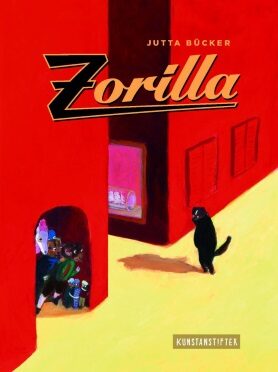Jutta Bücker
Zorilla
[Zorilla]
- Kunstanstifter Verlag
- Mannheim 2019
- ISBN 978-3-94279-571-6
- 36 Pages
- Publisher’s contact details
Sample translations
Fear of Strangers
Jutta Becker scored a sales hit in 2004 with ‘Rosalie und Trüffel’ and its cuddly pair of pigs, but this present picture book is a quite different proposition. The very name of its eponymous hero, ‘Zorilla’, may denote a type of African polecat, but it also alludes to Zorro and to gorillas. As might happen in a crime movie, Jutta Bücker chooses Hamburg’s street-scene as the backdrop to her story. The lights of Hamburg’s famous Fair gleam in the night sky. Decked in his pink stole the circus horse sits on a bar stool chatting to the walrus, on duty here as the local policeman. Jutta Bücker lives in Hamburg, its topography is familiar to her, and she uses it to great effect. The highly atmospheric setting lends the story extra intensity and conviction. The polecat comes across as alien and menacing not only to the animals within the story, but also to us - a sensation subtly reinforced by the fact that we, too, see only the whites of its eyes peering out from the overall blackness of the figure. But then Jutta Bücker switches perspective, for no sooner have we been discomfited by the strange creature’s inscrutability than we find the town’s citizens forming a mob: they, too, now radiate an air of menace.
The outsider becomes an object onto which the locals project their own fears. Thus for instance the rats suspect he’s out to drown them in the harbour. Suspicious noises are heard coming from the zorilla’s workshop. We see the frightened mice, the helpless little pig - the atmosphere becomes ever more tense. This tension is heightened by drawings that depict the actions in the foreground, but simultaneously recede into the far distance. This sense of depth lends the story a powerful extra dimension. At the same time Jutta Bücker uses stark colours conveying an undertone of hysteria: an aggressive yellow, a disconcerting pink, an oppressive green. The atmosphere is unmistakably poisonous - until all of a sudden everything changes.
Needless to say, the zorilla is not a monster at all: inside his workshop he has constructed a ship in a giant bottle, and during the night he has launched his bottle onto the water unnoticed in order to sail back home to Africa. And this ship in a bottle was already plainly to be seen on the cover of the book. The zorilla now comes across as small and wholly without menace: ‘If only they had asked the zorilla...’, we’re told at the start of the book’s second part, which depicts what had actually been happening and conveys the zorilla’s longing to get back home. The animals have thereby lost someone possessed of a clever mind and an inventive spirit.
With great subtlety in her depiction of the characters, their behaviour, and the overall setting, Jutta Bücker vividly confronts us with the consequences of xenophobia.
Translated by John Reddick

By Thomas Linden
Thomas Linden is a journalist (Kölnische Rundschau, WWW.CHOICES.DE) specializing in the areas of literature, theater and film. He also curates exhibitions on photography and picture book illustration.
Publisher's Summary
People near the harbour are worried: a Zorilla marten has settled in their town. Nobody knows where it came from, nor why it has come. What is the animal up to?
All the while, frenzied tales of its antics spread until, one day, a crowd of very concerned locals marches to its abode and is, to put it mildly, quite surprised!
The first version of the marten’s story was written by Jutta Bücker more than ten years ago. Her intention is not to preach but to invite readers to overcome their initial fears and engage in dialogue with what is thought to be so different.
A timeless and important story that can inspire courage and the overcoming of prejudice, to help everyone be more curious and interested in those they meet.
(Text: Kunstanstifter Verlag)
